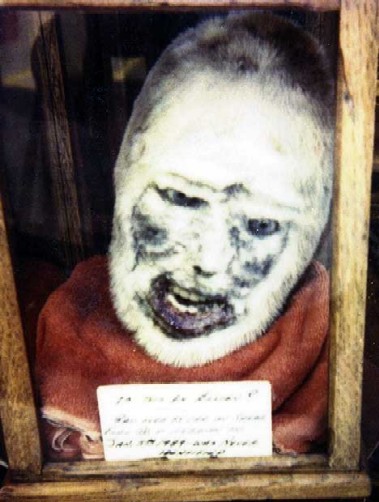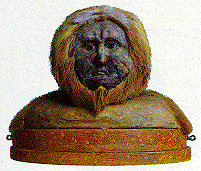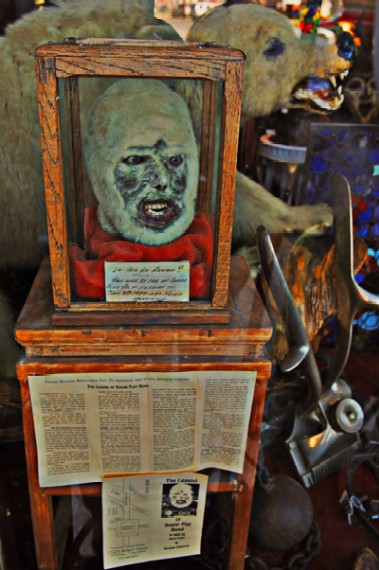
August 12, 2008

How many heads of “Bigfoot” are floating around this country? Is the Minnesota Iceman still available for exhibition? Does your local curio shop have the “stuffed head of Bigfoot”? What if one was real? Are we overlooking some piece of evidence here?
Back to the days of the “Nondescript,” strange heads of hairy seemingly bipedal man-beasts have turned up as curious items on display. The Nondescript was supposedly part of the shoulders and head of a monkey-like creature that had a long tail and thick fur. Charles Waterton had collected it in his travels in deepest, darkest Guiana. Unable to collect the whole body, Waterton brought just the upper torso and head out, he said. He wrote about it in 1825 in Wanderings in South America.

The Nondescript, of course, was a taxidermy hoax. While it looked almost like a bearded man in an Inuit hood, it was constructed from the head of a South American howler monkey, badly mounted. Perhaps most interesting, Waterton displayed this head frequently at a Jesuit preparatory school he had attended, Stonyhurst College, located in a fairly remote part of Lancashire. This school also had one member who had come after Waterton, and therefore would have been treated to this taxidermy hoax. That member of the Stonyhurst alumni was Arthur Conan Doyle.
While Sir Arthur Doyle may be remembered for his Sherlock Holmes stories, he is also considered one of the possible suspects involved in the Piltdown hoax, which occurred eight miles from his home. One of the most frequent visitors to the site was Sir Arthur Conan Doyle. And he was a friend of many of the “major players” in the Piltdown melodrama. Nondescript = evidence of a missing link, Piltdown = evidence of a missing link. Humm.
Fast forward to the contemporary. According to a 2005 article in the Nashville Scene by Justin Jones, I’m reminded of alleged taxidermy hoaxes still being pulled today, trying to prove a “missing link” is out there.
Take for example, the head of the “Creature of Sugar Flat Road.”
Supposedly, this Bigfoot-type creature was hit on Sugar Flat Road near where its final resting place is located. The head was “preserved” in a mounted fashion.
Back in 2005, you could see it in the window of Cuz’s Antique Center in the Lebanon Public Square, Lebanon, Tennessee. Images of it are at top and below.

Is there a Bigfoot head in your neighborhood curio shop? Let me know about it. Maybe one, someday, just might be authentic.
About Loren Coleman
Loren Coleman is one of the world’s leading cryptozoologists, some say “the” leading living cryptozoologist. Certainly, he is acknowledged as the current living American researcher and writer who has most popularized cryptozoology in the late 20th and early 21st centuries.
Starting his fieldwork and investigations in 1960, after traveling and trekking extensively in pursuit of cryptozoological mysteries, Coleman began writing to share his experiences in 1969. An honorary member of Ivan T. Sanderson’s Society for the Investigation of the Unexplained in the 1970s, Coleman has been bestowed with similar honorary memberships of the North Idaho College Cryptozoology Club in 1983, and in subsequent years, that of the British Columbia Scientific Cryptozoology Club, CryptoSafari International, and other international organizations. He was also a Life Member and Benefactor of the International Society of Cryptozoology (now-defunct).
Loren Coleman’s daily blog, as a member of the Cryptomundo Team, served as an ongoing avenue of communication for the ever-growing body of cryptozoo news from 2005 through 2013. He returned as an infrequent contributor beginning Halloween week of 2015.
Coleman is the founder in 2003, and current director of the International Cryptozoology Museum in Portland, Maine.
Filed under Artifacts, Bigfoot, Cryptomundo Exclusive, Cryptotourism, CryptoZoo News, Cryptozoologists, Cryptozoology, Evidence, Folklore, Forensic Science, Hoaxes, Museums, Sasquatch